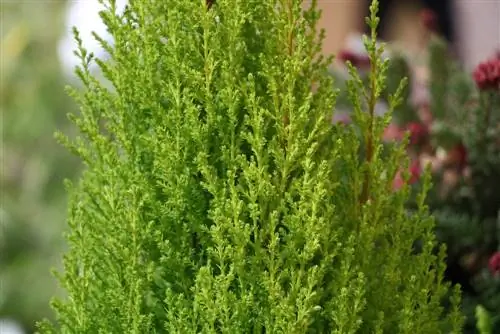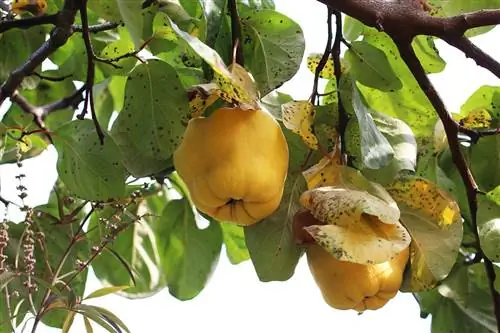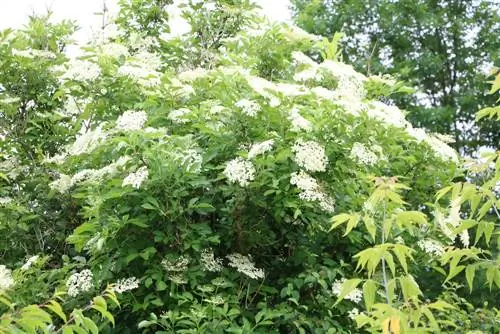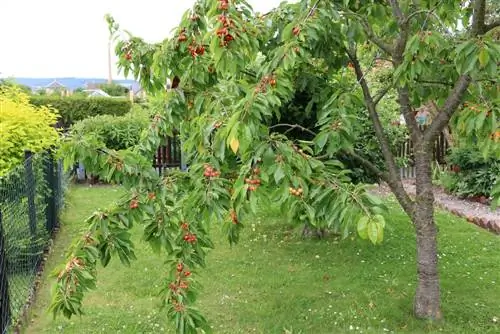- Author admin [email protected].
- Public 2023-12-17 03:39.
- Last modified 2025-01-24 12:45.
Cypresses belong to the conifer genus and are therefore even related to giant sequoias. Real cypresses come from the Mediterranean region, so-called false cypresses are native to North America and East Asia. The coniferous plants need nutrient-rich, loose soil that is rich in humus and kept moist.
Appearance and origin
Mock cypresses and real cypresses have only minor differences, so they can be treated the same when it comes to care. Cypresses grow either as shrubs or trees. The leaves are small and scale-shaped, they protrude crosswise from the branches. Cypresses are evergreen and hardy, although young plants in particular require additional winter protection. Numerous cultivated forms of these plants can be found on the market. Common and popular are, for example, blue hedge cypress, yellow garden cypress or white variegated cypress, which impress with their original look.
Location and use
All cypresses like sun, but can also thrive in a partially shaded location; these plants wither in the shade. The plants need nutrient-rich, loose soil that is rich in humus and kept moist. The cypress trees don't like waterlogging; too much water causes the plants to get unsightly yellow and brown spots. Cypress trees, both true and mock cypress, make excellent hedge plants. These trees impress with their fast and particularly dense growth. If a particularly wide hedge is desired, cypress trees can be planted in two or three rows. As a solitary tree, such a tree can reach a height of over ten meters and form a beautiful visual centerpiece, for example in the front garden. Cypresses also look pretty chic as a potted plant on the terrace, at the entrance to the house or on the balcony.
Setting the plants
Cypresses are usually sold as small trees between 80 and 120 cm high in a plastic container. The planting hole for the young plant should be approximately twice as large as the container. Compost or garden soil is poured into the bottom of the planting hole and a portion of the special conifer fertilizer is added. The dosage can be found on the packaging with the fertilizer and should not be exceeded. Compost or garden soil should also be added to the sides of the plant. It is important to firmly tread the soil around the plant so that it does not tip over with the first gust of wind. The optimal distance between the individual hedge plants is approx.50cm. Immediately after planting, the cypress should be watered thoroughly, even if it rains. Conifers are best planted in autumn; the gardener can start planting these plants from the end of August.
Care
After planting in autumn, the cypresses do not need any further addition of fertilizers, just regular watering. When preparing for winter, the gardener should remember that young trees are particularly sensitive. Although these plants are hardy, that doesn't mean they don't need protection in the winter. A solitary plant can be protected from the cold with a few layers of fleece. With the hedge it is of course more difficult; here, for example, leaves piled up around the tree trunks can help.
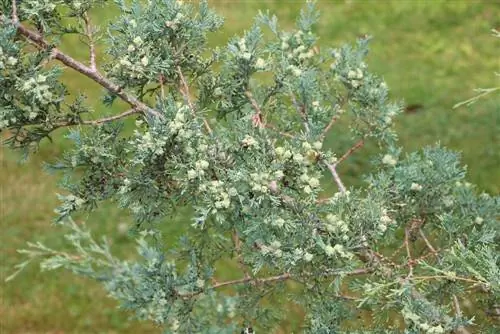
In winter the plants live on, so it is important to water them at this time of year too, although not as extensively as in summer. In spring the plant begins to grow. Now, in April, is a good time for a portion of slow-release fertilizer and fresh compost soil. Otherwise, cypresses require little care; it is important to check regularly whether the trees have enough water. Cypresses react to both dryness and waterlogging with yellow or brown spots.
- Sandy, humus-rich soils are preferred. Cypresses do not place high demands on the location.
- It is important for cypresses, as well as other evergreen trees, that they are watered sufficiently, even in winter.
- Most evergreen trees do not freeze, the damage is more likely due to dryness.
- Especially when cypresses are exposed to wind, they have an increased water requirement.
- The soil should never dry out.
- Most of the cypresses planted in our latitudes tolerate pruning from time to time.
Diseases and pests
Unsightly white, yellow or brown spots are not always a sign of problems with lack of or excessive watering. On the one hand, brown tips can be associated with the growth and annual self-renewal that is typical of evergreen plants. This phenomenon is called “preening” and is usually observed in autumn, less often in spring. On the other hand, yellowed branches often indicate that the plant is ill. Although cypress plants are generally robust representatives of the flora, they are susceptible to some pests and diseases. Fungal infections are particularly unpleasant because there are currently no effective antidotes. Experience has shown that radical pruning helps, although this is not good for the appearance of a beautifully trimmed hedge. Trees and bushes affected by bark beetles, mealybugs and leaf miners must be treated immediately with insecticides.
Cutting
The right time for pruning is spring, when the plant begins to sprout. If necessary, you can cut again in autumn (end of August - beginning of September). When cutting, it is important to remember that cypress trees do not tolerate cutting into the wood well and react to this by forming bald spots. Otherwise, they allow the cypress trees to be cut well and are also well suited for a beautiful topiary. Both hedges and solitary plants can be cut using a specially made template; it is advisable to start with the crown. For optimal cutting of these plants, mechanical secateurs are preferable to electric hedge trimmers as they allow more precision. This slows down the work process, but the result proves that the effort was worth it.
The most important things about the cypresses in brief:
- evergreen trees and shrubs,
- love sun, can also tolerate partial shade,
- ideal as a hedge plant, but also a beautiful solitary plant,
- robust, most diseases can be easily treated,
- needs a lot of water, doesn't like waterlogging,
- perfect for topiary
- easy-care and durable
- Visibility and wind protection and garden decoration
- not all varieties are hardy
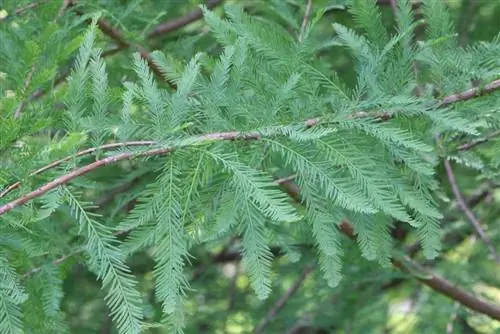
The real cypress, also called Mediterranean cypress, can even tolerate some drought and temperatures down to around -15 °C, but only with sufficient winter protection. This is why real cypress is more suitable for milder wine-growing regions. This way you can get the cypress hedges into good shape and keep them. The fruits of the cypress trees are used to produce oil, which is often used in herbal medicine.
Many different cypress and false cypress varieties are available in nurseries and mail-order nurseries. Plants around 1 meter high are ideal for new plantings. Don't plant too densely. Since cypresses grow relatively quickly, a dense hedge will soon form. Popular varieties include false cypresses, with steel-blue needles and hanging growth, but also dwarf cypresses. The dwarf varieties are also very suitable for large pots or troughs.

